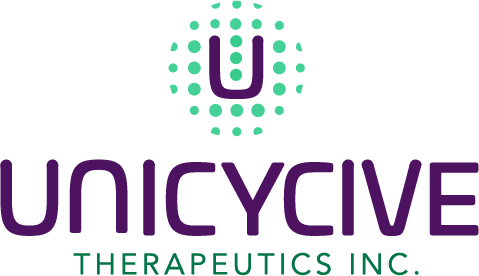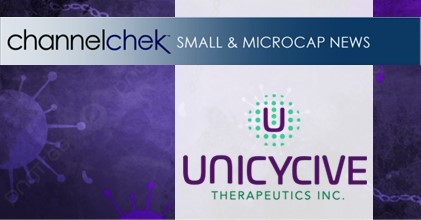
Research News and Market Data on UNCY
Unicycive Therapeutics Presents Bioequivalence Data On Oxylanthanum Carbonate (OLC) At The National Kidney Foundation Spring Clinical Meeting
May 15, 2024 7:03am EDT Download as PDF
– OLC Demonstrates Bioequivalence to Lanthanum Carbonate –
– Additional Poster Highlights Key Features of OLC as Perceived by Renal Dieticians –
LOS ALTOS, Calif., May 15, 2024 (GLOBE NEWSWIRE) — Unicycive Therapeutics, Inc. (Nasdaq: UNCY), a clinical-stage biotechnology company developing therapies for patients with kidney disease (the “Company or “Unicycive”), today announced that two posters related to the Company’s lead product candidate, oxylanthanum carbonate (OLC), were presented at the National Kidney Foundation (NKF) Spring Clinical Meeting. OLC is a next-generation lanthanum-based phosphate binding agent utilizing proprietary nanoparticle technology being developed for the treatment of hyperphosphatemia in patients with chronic kidney disease (CKD).
“The NKF Spring Clinical Meeting was an important meeting for Unicycive as we were able to present data from the OLC bioequivalence study and our second poster was featured as a top-rated submission,” said Shalabh Gupta, MD, Chief Executive Officer of Unicycive. “Phosphate binders are integral to the management of hyperphosphatemia in patients with CKD and their effectiveness is adversely affected by non-adherence and limitations of phosphate binding capacity relative to dietary intake. Our data confirms that OLC is bioequivalent to lanthanum carbonate (LC) by showing similar outcomes in both groups with respect to mean change in urinary phosphate excretion. Importantly, OLC demonstrated a well-tolerated safety profile with no serious adverse events. This data is important as it serves as one of the key components for our New Drug Application filing with the FDA under the 505(b)(2) regulatory pathway.”
Dr. Gupta, concluded, “We are grateful to Dr. Hill Gallant who delivered a poster presentation on a survey of renal dieticians who play a critical role in helping patients manage serum phosphate and are close witnesses to patients’ experiences and challenges with phosphate management. The findings of the survey concluded that strategies that reduce pill burden and increase ease of use for patients are needed, reinforcing our belief that, if approved, the characteristics of OLC including the reduction of pill volume may increase compliance and improve the quality of life for patients living with this condition.”
Presentation Details:
Title: Two-Way Crossover Study to Establish Pharmacodynamic Bioequivalence Between Oxylanthanum Carbonate and Lanthanum Carbonate
Lead Author: Vandana Mathur, MD
Results: The poster presentation described the results of the randomized, crossover bioequivalence study comparing OLC with lanthanum carbonate (LC). The study was a Phase 1, single-center, randomized 1:1, open-label, controlled, 2-way crossover study designed to demonstrate the pharmacodynamic (PD) equivalence between two phosphate binders: orally administered OLC as compared to LC. Both treatments were administered at doses of one 1000 mcg tablet three-times-a-day (TID) in healthy volunteers who received the same standardized meals to control for daily phosphate intake. OLC tablets are swallowed whole as opposed to the LC tablets that must be chewed completely. The study consisted of a screening period, two dosing periods separated by a 14-day washout period, and a follow-up period 7 days after last study drug dose. The primary PD variable was Least Squares (LS) mean change in urinary phosphate excretion from baseline (48hrs prior to dosing) to Evaluation Period (Days 1-3). The baseline characteristics were balanced between OLC/LC and LC/OLC sequences. LS mean change from baseline for OLC (-320.4mg/day) was similar to the LS mean change from BL for LC (-324.0mg/day). The 90% confidence interval for the LS mean change in urinary phosphate excretion from baseline (test-reference) was (-37.83, 45.12), which was entirely contained within the predefined ±20% acceptance range of (-64.80, 64,80). There were no serious adverse events (SAEs) and no treatment discontinuations. The incidence of treatment-emergent adverse events (TEAEs) and related AEs were also the same in both groups at 35% and 25%, respectively.
Title: Renal Dietitians Perceive Phosphate Binder and Low-Phosphate Diet Non-Compliance as Top Reasons for Above Target Serum Phosphorous Concentrations
Lead Author: Kathleen Hill Gallant, PhD, RD
Results: The poster presentation delivers results of a recent dietitian survey evaluating perceived reasons for noncompliance to phosphate binder (PB) therapy and identifies the most appealing potential aspects of OLC. The poster concluded that strategies that reduce pill burden and increase ease of use for patients may promote PB treatment compliance, which may improve patient outcomes. OLC, which is a smaller tablet that can be swallowed whole without chewing, may address compliance issues seen with current PBs. In fact, 47% of dieticians noted the high perceived potency of OLC and 34% noted its perceived lower number of pills required as the most appealing aspects of OLC.
Recent studies reported PB non-adherence rates of up to 78% in patients with end-stage kidney disease on dialysis. For the analysis, 100 renal dietitians were surveyed and there were several key findings. The most common reasons for phosphate levels above the target range were non-compliance to PB prescription (36%) or low phosphate diet (34%). The two leading reasons for PB discontinuation were too many pills and formulation issues. One-third of dietitians attributed non-compliance with patients forgetting to take their PBs with meals or snacks and 16% attributed it to high pill burden.
About Oxylanthanum Carbonate (OLC)
Oxylanthanum carbonate is a next-generation lanthanum-based phosphate binding agent utilizing proprietary nanoparticle technology being developed for the treatment of hyperphosphatemia in patients with chronic kidney disease (CKD). OLC has over forty issued and granted patents globally. Its potential best-in-class profile may have meaningful patient adherence benefits over currently available treatment options as it requires a lower pill burden for patients in terms of number and size of pills per dose that are swallowed instead of chewed. Based on a survey conducted in 2022, Nephrologists stated that the greatest unmet need in the treatment of hyperphosphatemia with phosphate binders is a lower pill burden and better patient compliance.1 The global market opportunity for treating hyperphosphatemia is projected to be in excess of $2.5 billion in 2023, with the United States accounting for more than $1 billion of that total. Despite the availability of several FDA-cleared medications, 75 percent of U.S. dialysis patients fail to achieve the target phosphorus levels recommended by published medical guidelines.
Unicycive is seeking FDA approval of OLC via the 505(b)(2) regulatory pathway. As part of the clinical development program, two clinical studies were conducted in over 100 healthy volunteers. The first study was a dose-ranging Phase I study to determine safety and tolerability. The second study was a randomized, open-label, two-way crossover bioequivalence study to establish pharmacodynamic bioequivalence between OLC and Fosrenol. Based on the topline results of the bioequivalence study, pharmacodynamic (PD) bioequivalence of OLC to Fosrenol was established.
Fosrenol® is a registered trademark of Shire International Licensing BV.
1Reason Research, LLC 2022 survey. Results here.
About Hyperphosphatemia
Hyperphosphatemia is a serious medical condition that occurs in nearly all patients with End Stage Renal Disease (ESRD). If left untreated, hyperphosphatemia leads to secondary hyperparathyroidism (SHPT), which then results in renal osteodystrophy (a condition similar to osteoporosis and associated with significant bone disease, fractures and bone pain); cardiovascular disease with associated hardening of arteries and atherosclerosis (due to deposition of excess calcium-phosphorus complexes in soft tissue). Importantly, hyperphosphatemia is independently associated with increased mortality for patients with chronic kidney disease on dialysis. Based on available clinical data to date, over 80% of patients show signs of cardiovascular calcification by the time they become dependent on dialysis.
Dialysis patients are already at an increased risk for cardiovascular disease (because of underlying diseases such as diabetes and hypertension), and hyperphosphatemia further exacerbates this. Treatment of hyperphosphatemia is aimed at lowering serum phosphate levels via two means: (1) restricting dietary phosphorus intake; and (2) using, on a daily basis, and with each meal, oral phosphate binding drugs that facilitate fecal elimination of dietary phosphate rather than its absorption from the gastrointestinal tract into the bloodstream.
About Unicycive Therapeutics
Unicycive Therapeutics is a biotechnology company developing novel treatments for kidney diseases. Unicycive’s lead drug candidate, oxylanthanum carbonate (OLC), is a novel investigational phosphate binding agent being developed for the treatment of hyperphosphatemia in chronic kidney disease patients on dialysis. UNI-494 is a patent-protected new chemical entity in late preclinical development for the treatment of acute kidney injury. For more information, please visit Unicycive.com and follow us on LinkedIn and YouTube.
Forward-looking statements
Certain statements in this press release are forward-looking within the meaning of the Private Securities Litigation Reform Act of 1995. These statements may be identified using words such as “anticipate,” “believe,” “forecast,” “estimated” and “intend” or other similar terms or expressions that concern Unicycive’s expectations, strategy, plans or intentions. These forward-looking statements are based on Unicycive’s current expectations and actual results could differ materially. There are several factors that could cause actual events to differ materially from those indicated by such forward-looking statements. These factors include, but are not limited to, clinical trials involve a lengthy and expensive process with an uncertain outcome, and results of earlier studies and trials may not be predictive of future trial results; our clinical trials may be suspended or discontinued due to unexpected side effects or other safety risks that could preclude approval of our product candidates; risks related to business interruptions, which could seriously harm our financial condition and increase our costs and expenses; dependence on key personnel; substantial competition; uncertainties of patent protection and litigation; dependence upon third parties; and risks related to failure to obtain FDA clearances or approvals and noncompliance with FDA regulations. Actual results may differ materially from those indicated by such forward-looking statements as a result of various important factors, including: the uncertainties related to market conditions and other factors described more fully in the section entitled ‘Risk Factors’ in Unicycive’s Annual Report on Form 10-K for the year ended December 31, 2023, and other periodic reports filed with the Securities and Exchange Commission. Any forward-looking statements contained in this press release speak only as of the date hereof, and Unicycive specifically disclaims any obligation to update any forward-looking statement, whether as a result of new information, future events or otherwise.
Investor Contact:
ir@unicycive.com
(650) 543-5470
SOURCE: Unicycive Therapeutics, Inc.
Released May 15, 2024
